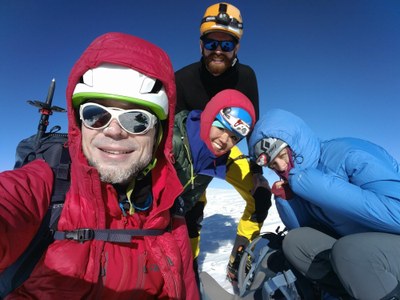
Trip Report
Intermediate Ice Climb - Mount Hood/Pearly Gates (late fall)
A full value intermediate climb, conditioner, and early season scouting trip, with a satisfying amount of hard snow, alpine ice, water ice, and thin ice over rock on the route, on a wonderful calm and sunny blue bird day during the capricious shoulder season.
- Fri, Nov 22, 2019
- Intermediate Alpine Climb - Mount Hood/Pearly Gates
- Mount Hood/South Side
- Climbing
- Successful
-

- Road suitable for all vehicles
-
Approach to Hogsback mostly over hard snow, no flotation needed, icy near the top. Bergshrund in places thinly covered with fresh snow, extra care needed while crossing. Entry into the chute on patches of consolidated snow and hard ice. Inside the chute, a pitch of alpine and brittle water ice, thin ice over rock, and short runout. Catwalk crossing from the summit to the descent chute has a short, but exciting section of exposed down-climbing with a view of North face on the left, steep cliffs on the right, whole life in front of your eyes, but secure tools purchase and good snow under your feet. Hard snow in the descent chute, crusty in places, offers 600 feet of tiresome downclimbing and frontpointing (conditioning opportunity, check).
Waiting for the winter to come was becoming unbearable, and with the reported ice sightings in the Pearly Gates chutes already in the first half of November, a solid weather window, and a vacation day to burn, an opportunity presented itself to scout the conditions and kick-start the season with a solid intermediate ice outing. Within half a day, we had a strong and committed team of 4 ready to wrestle the mountain, and the stoke was high.
We left from Seattle on Thursday evening, and with less traffic than expected, we arrived a bit early. We found that the Huckleberry Inn in Government Camp was open 24-hour, and we used the extra time to eat a solid breafkast. All of us were a little sleep-deprived after the exhausting drive and a busy working week, and with the night of climbing ahead, the coffee was badly needed.
We arrived at an empty Timberline Lodge lot 12:30am, a bit ahead of our 1am meeting time, filled out self-issue permit, and geared up. It was very chilly outside. Caught up the last bit of warm and ate some food waiting in the car for the last climber to arrive and gear up, and hit the trail together at 1:30am.
On the way up, we followed a curvy snowcat track. Snow coverage was thin, and we were walking partially on snow, partially on dirt in places. Neither flotation, nor crampons were necessary. The snow was starting to ice up in places, but the crust was breaking easily under our feet.
We made it to the top of the Palmer lift at 8500 in about 2 hours, by 3:30am, and took a 5-minute break there.
After another 1:40, we got to the spot just south the Crater Rock, at about 9,660, immediately before the eastward traverse. The icy crust on the snow was getting hard, and going forward, we would be traversing over sections where a fall would result in a long slide, so we took a longer 30-minute break here to catch a breath and to take in the rotten egg smell from the fumaroles, as well as to put on crampons, harnesses, get screws out and and all the gear in place. After a brief team discussion, though, we chose not to rope up just yet.
At about 5:50, we started the traverse and climb up and clockwise around the Devil's Kitchen area to get to the base of Devil'ls Kitchen, as the plan was to scout the conditions there first on the off chance that there might be just enough thin ice in the slot to climb it. This wasn't really going to happen, but a boy can dream, and there's nothing like seeing the conditions first-hand.
The slopes above the fumaroles were hard and icy. We soloed that section. Even there, we appreciated having two tools. Just as we were approaching the DKH chute, first sunlight started to hit upper slopes, and a steady shower of tiny rime ice projectiles at ballistic speeds started zipping around our ears and bouncing off our helmets. That this happened wasn't a surprise, but the intensity of it already at this early hour was higher than expected. I regretted not putting sunglasses on before entering that portion. Fortunately, we all got away unscathed.
Jonathan and Krzys enjoying some satisfying ice sticks:
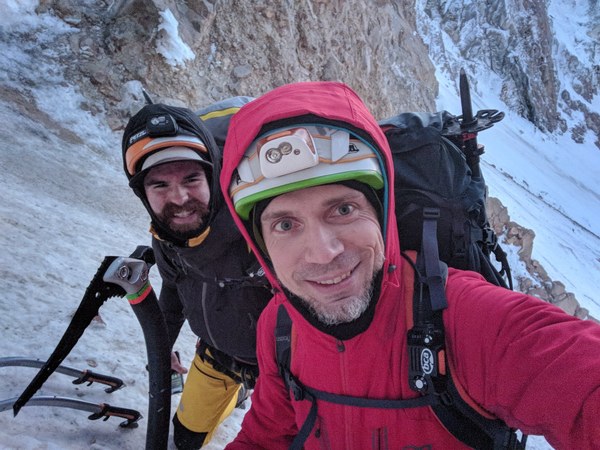
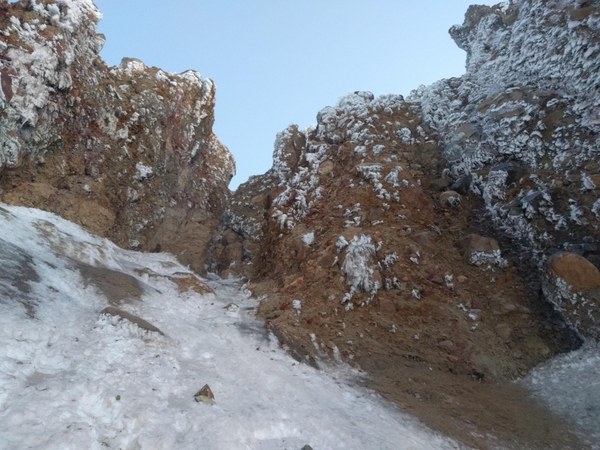
After almost exactly 1 hour from the start of the traverse, right about 6:50, we entered the Devil's Kitchen and were staring at the cruxy first ice step. The sky was getting light, and we could see the crux clearly without headlamps. The timing couldn't be more perfect.
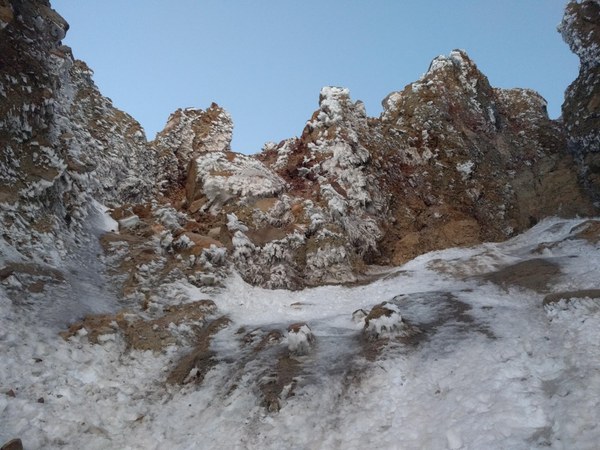
After a brief group discussion, we decided that there's no chance in hell of the route being climbable, as indeed we had expected. Several spots were already covered in thin ice, but the step was bare rock, and it was pretty clear that this would be mixed climbing, extremely sketchy at best. After taking a couple closeup shots, we turned back to traverse to the Pearly Gates, mostly on the rock ledges. Approach towards the gates offered another section of hard snow and ice crust, moderately steep and secure enough to continue low-dagger unroped.
Jonathan happily cruising on the steep slope leading to the gates:
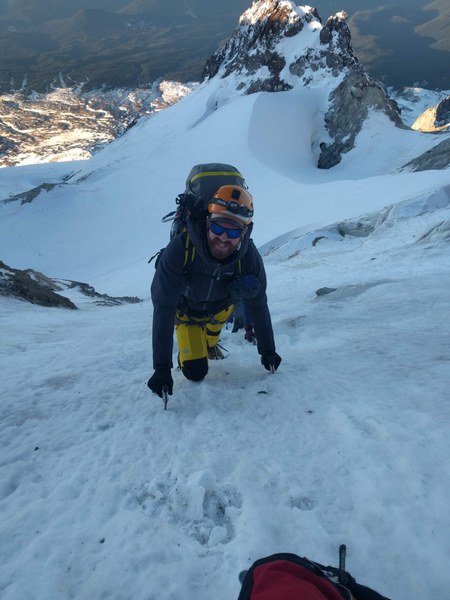
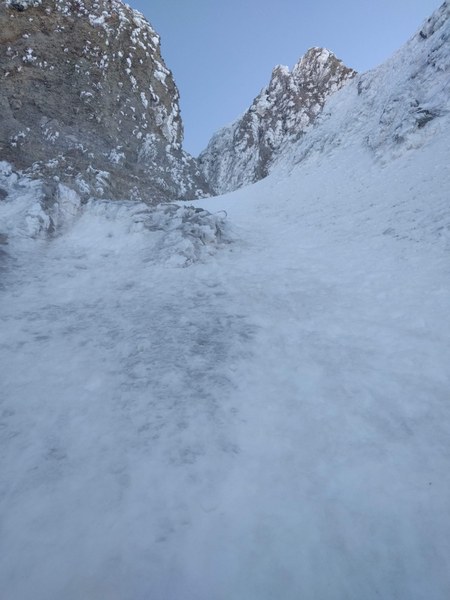
Near the entry to the gates, hard snow became ice, and the shower of ice projectiles shooting out of the gates was becoming more intense.
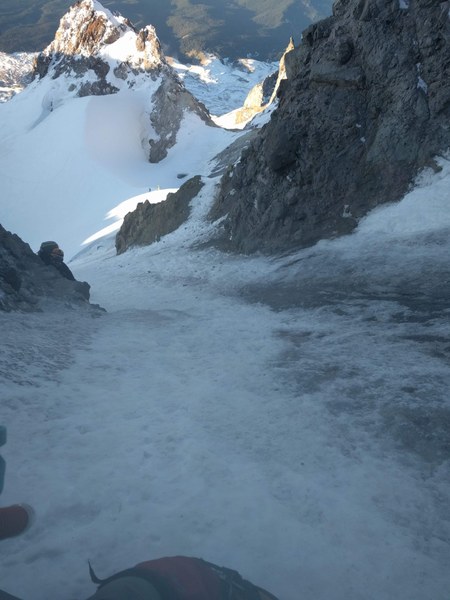
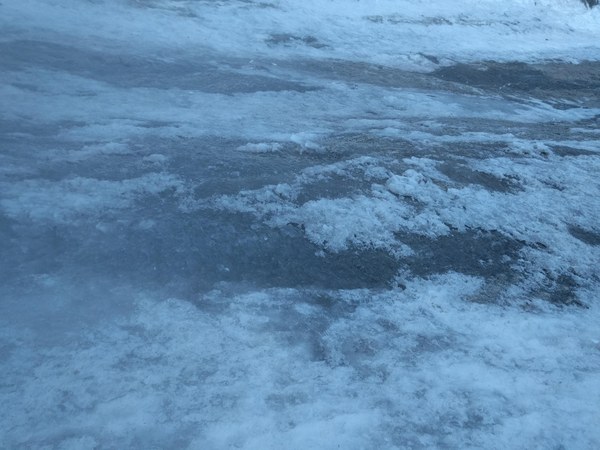
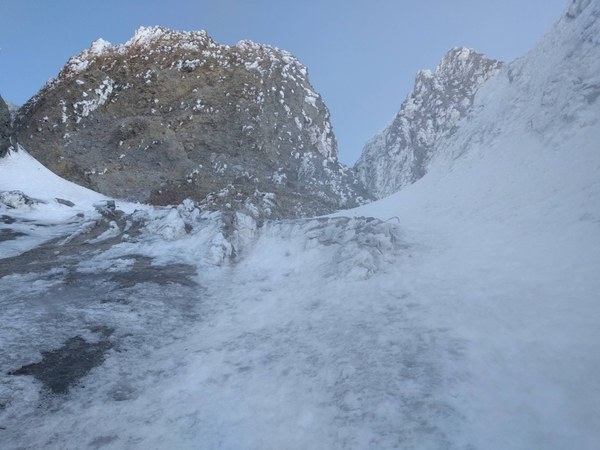 Once inside the gates, the path splits into two corridors, as is best illustrated on the Google Earth picture below. Both of them eventually join on the moderate upper slopes. The left one was starting with what looked like at least a 10-12 foot step of fat alpine ice. Unfortunately, the picture that I took came out blurry. We opted for the right variant.
Once inside the gates, the path splits into two corridors, as is best illustrated on the Google Earth picture below. Both of them eventually join on the moderate upper slopes. The left one was starting with what looked like at least a 10-12 foot step of fat alpine ice. Unfortunately, the picture that I took came out blurry. We opted for the right variant.
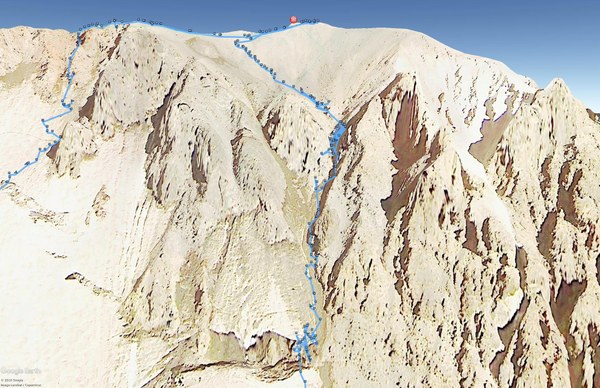
The right variant was also offering an ice step right from the start, beginning with a moderately steep-looking water and rime section that turned out to be harder than it looked at first. We were not sure what we may find after the initial step, but Sara was pretty confident that it would flatten out eventually, so we gave it a go. This is where we roped up and put in a pair of 16cm screws for the belay. From the look of it, the ice seemed like it would be pretty solid.
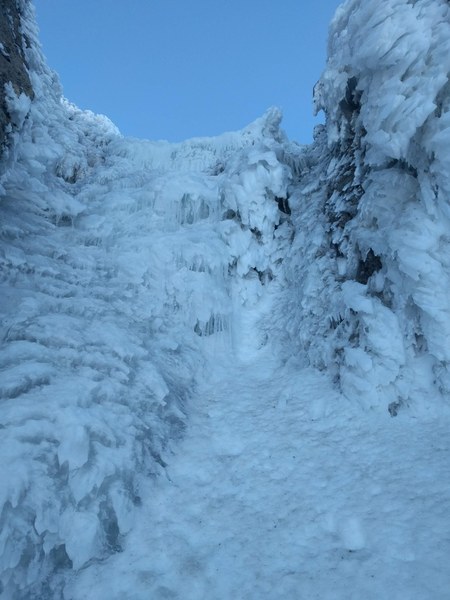
Started the lead up and left in the arete. The step was somewhat steep, and upon getting hit by a tool, the ice felt a bit brittle. This did not inspire quite as much confidence as it initially seemed it would, so chopped a few initial steps to get some secure footing in for a good start. The left side, fortunately, offered good stemming, which helped. Putting in good screws required a good bit of cleaning, so the group at the belay got a big shower of pellets. The bridge of my nose took a hit as well, and remained bloodily stylish for the remainder of the trip.
After the initial brittle-feeling, but nevertheless overall still reasonably secure-feeling bottom section of ice that took 10cm and 13cm screws, coverage got thinner, and my tool picks were now consistently hitting bare rock and chopping dinner plates off of it (indeed, I later found that one of my tool picks got blunted). Screw placements got harder to find, and a bit of a runout was needed. Fortunately, before long, a rightward traverse opportunity onto a nice, fat flow of blue alpine ice presented itself. A solid screw went in, and a couple of steps across to the right led to nice secure footing that again felt good.
After the step-across, it was continued alpine ice and water ice for a couple more stretches, with some slightly steeper portions, but all with bomber screw placements.
Overall, climbing this pitch felt reasonably secure, but still somewhat sustained, at what we felt was between WI2+ and WI3 in places, mostly due to variable-quality ice and protection options, and it required focused attention, so we didn't have the chance to take pictures of the mid-route portion.
The top-out on the easy slopes offered a final sheet of alpine ice. The ice felt soft, necessitating 3 x 16cm screws. Tried to reinforce the anchor with a picket, but even with really hard pounding, pickets would not sink more than about a foot in, likely hitting rock or hard ice underneath. We did not encounter any picket opportunities on the entire climb (which wasn't unexpected, but we still opted to carry one per person just in case; indeed, this time it wasn't necessary).
By about 10:30, or just about 3 hours from the end of the traverse from Devil's Kitchen at 10,600 and the beginning of the climb into the gates, everyone has come up, and we went on the final short walk along moderated slopes to the summit. The summit was empty, the sky was clear, and we could see far in every direction.
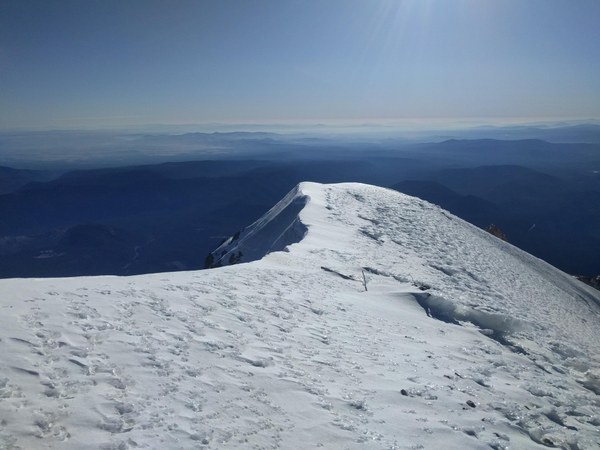
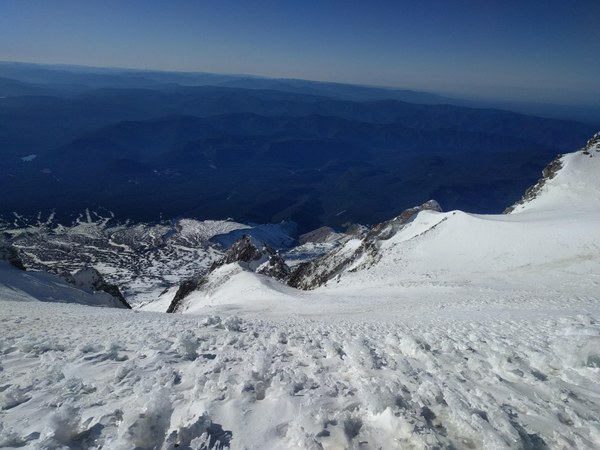
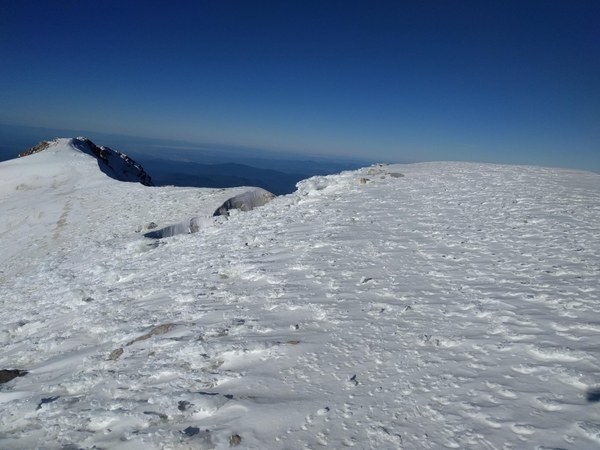
Obligatory summit selfie at 11am sharp.
Jonathan, Meredith, Sara, and Krzys at the summit:
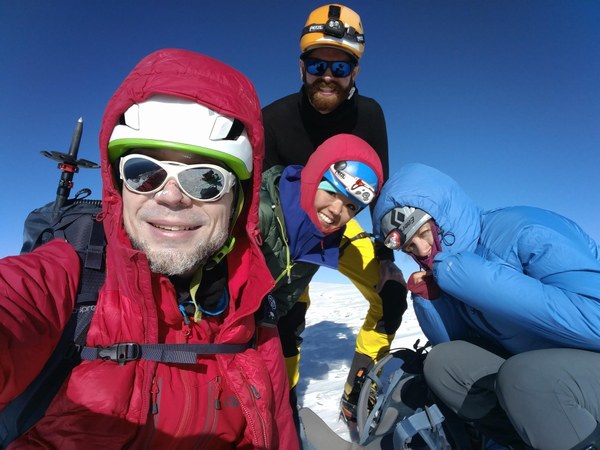
After briefly taking in the views, and taking a frightening peek across the sharp edge of the North Face (too frightening to post), we headed west along the summit ridge towards the traverse to the Old Chute to descend.
A portion of this traverse, known as the catwalk, was in spicy late-November conditions, and it took us time to negotiate. The down-stepping was very exposed, with the heart pumping view of the insanely steep North Face on the left side, a steep chute on the right, and not being able to see one's foot placements. The tool purchase in the hard snow was solid, though, and Jonathan who's done it several times before took a confident lead and demonstrated the way it's done. All survived.
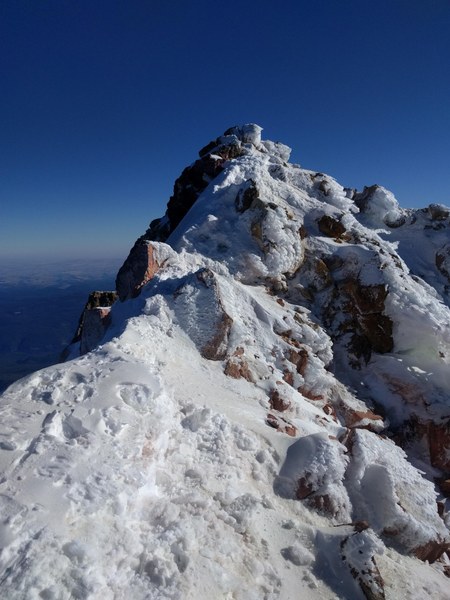
We started down-climbing the Old Chute at around 11:30am. The chute started steep, and then continued moderately steep, but on hard snow, just enough that plung stepping was impossible, and requiring us to down-climb and frontpoint with two tools along the entire length, or about 600 feet to get to the spot when one could turn around and walk the rest of it down, which took nearly an hour, as we were already tired by then and needed to pause every once in a while.
Meredith in the middle of the 600-foot downclimb of the Old Chute:
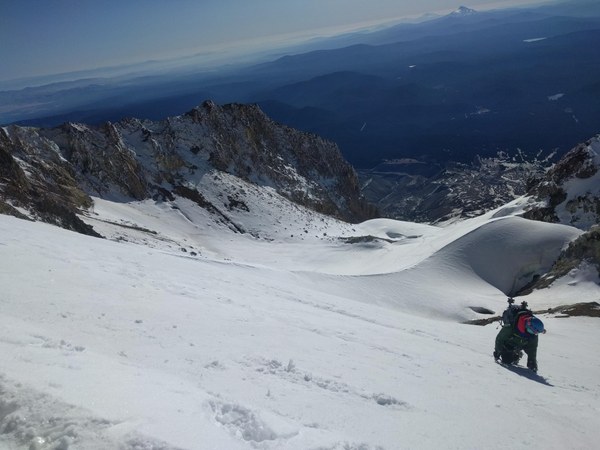
From 10,600, it was a quick and easy walk to Hogsback, where at 12:30pm we took a short break, and some of us degeared. The fatigue was starting to set in, so I opted to take the opportunity to lean against my pack instead to eat and drink something, and to briefly drift away.
Alas, that didn't take too long, as getting off the mountain was a priority. Unlike on the way up, when we couldn't see anything past the end of the weak beam of a headlamp, the descent offered us a view of the whole mountain slope ahead, and we were able to pick a path down softer snow, initially west and then east of the path we ascended.
One the way back, I took a picture of the Steel Cliffs, a project for the first weekend of January. Still only very lightly peppered with new snow, and melting fast as we speak.
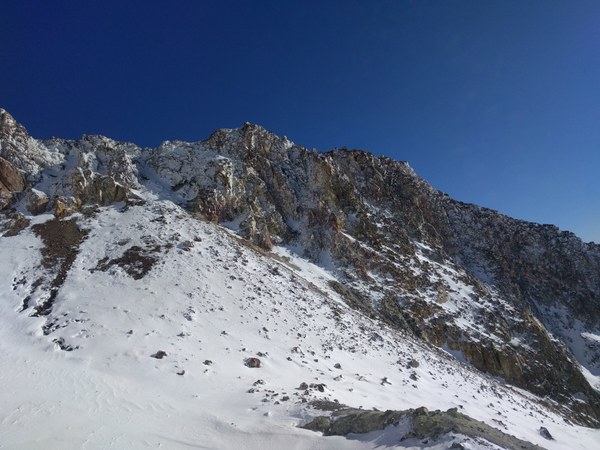
Getting off the mountain took about 3 hours, perhaps a bit on the longer side. My knees are weak, and going down is always an absolute bloody murder. We made it back to the parking lot just after 3:30pm. All of us were completely wiped out by that time, and the group consensus was that everything hurts. We definitely got a full value out of the climb in every respect: as a scouting trip, as a perfectly legit intermediate ice climb, and as an early season conditioner, all nicely bundled in one-day package.
As we were peeling boots from our sore feet, it took no more than about 60 seconds for the stoke to return in full strength for my upcoming climbs of Hood this winter. Can't wait.
The entire route we followed in Google Earth:
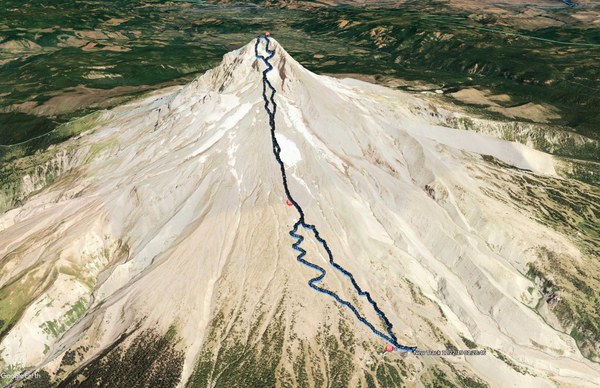
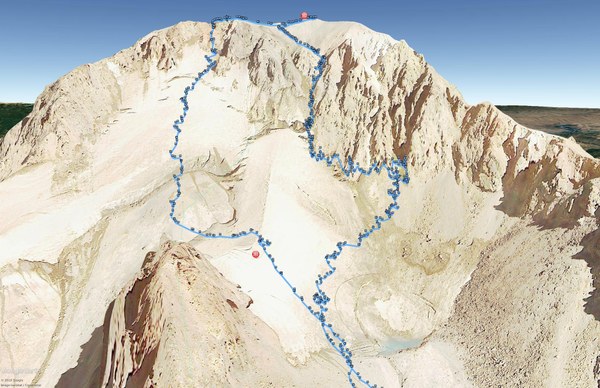
The GPX track:
https://www.peakbagger.com/climber/GPXFile.aspx?aid=1282710&sep=1
 Krzysztof Ostrowski
Krzysztof Ostrowski